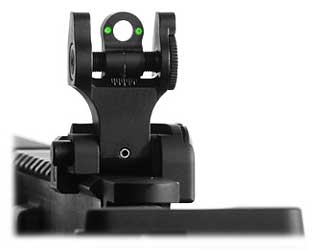Table of Contents
Unless you have been living under a rock you are probably familiar with the name Glock. This company has been manufacturing high quality firearms for over 30 years and don’t look like they’re stopping anytime soon. The Glock 17 and Glock 19 are the two handgun that started it all for the company. In this article we focus on the Glock 19 and its fiber optic and tritium sights. The Glock 19 is now in it’s 4th iteration. Fans and gun enthusiasts alike have named it the Glock 19 Gen 4.
Overview: Glock 19 Gen 4
This Gen 4 version comes with a whole slew of upgrades. There are four major upgrades to the Glock 19. First what they call the Modular Back Strap System. This allows the shooter to adjust the back strap to his or her liking. At it’s smallest range it reduces the trigger distance by .08 inches. The medium backstrap can be attached which adds another .08 inches (essential the size of a standard frame). Finally, adding the large backstrap will push the distance up to .16 inches from the trigger. This customization makes the Glock suitable for all hand types.
Another wonderful feature is the reversible enlarged magazine catch. This allows the gun to be ambidextrous to the advantage of both right and left hand shooters. Their dual recoil spring assembly lengthens the life span of the piece while minimizing recoil. The last feature is the rough textured frame. This is a cosmetic upgrade that allows for a better grip on the gun. All of these improvements have made the Glock 19 Gen 4 one of the more popular CCW handguns. It’s classic polymer design makes this 9mm handgun tough and able to handle most scenarios. I have shot it under blue skies and have fired it in the mud and it continues to shoot beautifully.
Customizing Glock Sights
Guns are seemingly fairly simple to operate – point and shoot. Essentially, that is all there is to it. When you are at the range or training grounds, it is relatively easy to acquire your target and fire. On the other hand, anyone who has ever been in a situation where self-defense called for the unholstering of a firearm knows that acquiring a target under pressure can be a lot more difficult. This is why it is of the utmost importance to have reliable Glock 19 sights on your gun. The sights, one of the most popular Glock 19 areas of modification, are there so when the situation demands immediate action, you will not be caught unaware. Acquiring the sights that are right for you, getting to know them, and training with them will help you be ready for the time when you need them.
This is especially true when conditions are not as ideal as they are at the ranges. Moving targets, harsh weather, sounds, and lights – these are all factors which should be considered. Sometimes, they are unavoidable, and they can all contribute to your missing the mark.
The Glock 19 comes with factory-made front and rear sights. They are made of polymer, the same material that makes up the gun. The factory sights have white dots on them, designed for quickly finding the target. The front sight is fixed, and the rear sight can be adjusted. Many people choose to take a marker and darken the rear sight’s white elements, so that only one white dot appears.
The standard height of the front sight on a Glock 19 is 0.165 in. The rear sight’s height is 0.256 in. Rear sights are also available in 0.24 in., 0.27 in., and 0.29 in. The length between the sights is 6.02 in.
As far as ballistics is concerned – changing the rear sight will result in a shift of approximately 1.97 in. over a 27 yards distance.
Fiber Optic and Tritium Sights

There is a vast difference between shooting during the day, and shooting at night. For this reason, many companies – including Glock itself – have created night sights. Many different brands of night sights are available, and they are usually made with either Tritium or fiber optics. Some sights, such as the TruGlo Brite-Site, incorporate the two, creating Tritium fiber optics (TFO) sights. Tritium and fiber optics have their separate strengths and weaknesses. Tritium are sights which are gaining a lot of popularity. In the day time they act as ordinary sights, and at night they light up very bright. Tritium is a radioactive substance, and it can be expected to last between 12-15 years if properly maintained.
Fiber optic sights function by collecting visible light and concentrating it. In other words, they will appear very bright when there is light, but at night – or, rather, with no source of light to collect – they will not be of much use. And, as mentioned, there are sights which incorporate the two. During the day, the fiber optics will emit a bright light, and at night the Tritium elements will glow. The main drawback of these sights is the price, and the fact that the Tritium has a shelf life, unlike the fiber optics.

As a general rule, choosing the best sights depends on the individual, and on the gun’s objective. If someone, for instance, works a night job, and knows that they will only be carrying their weapon at night – Tritium is the way to go. If, on the other hand, a person is a competition shooter, or a strict daytime carrier – fiber optics are the clear choice. There is no “best” option. It greatly depends on the needs of the individual.
Conclusion
Popular Glock sights are made by Trijicon, Meprolight, AmeriGlo, Battlehook, Truglo, XS, and Glock itself. In order to install the sights, you will need the right tools and the know-how. Some sights are easy to install. With others, it is recommended to take them to a gunsmith rather than to attempt self-installing. For regular sights, tools like a sight pusher are recommended. For night sights or tritium sights, the tools become a necessity. An experienced gunsmith will have no trouble installing your Glock 19 sights.
For more on the Glock 19, check out our Glock 19 vs Glock 17 and Glock 19 vs Glock 26 comparisons!



I am actually looking for lower-cost options with good quality and it seems that UTG bipods are recommended here although I’m also eyeing the Harris bipod. I think I’m gonna go with the Harris bipod